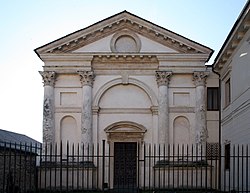| Church of Santa Maria Nuova | |
|---|---|
 | |
| Religion | |
| Affiliation | Roman Catholic |
| Location | |
| Location | Vicenza, Veneto, Italy |
 | |
| Architecture | |
| Architects | Andrea Palladio, Domenico Groppino |
| Type | Church |
| Style | Renaissance |
| Groundbreaking | 1578 |
| Completed | 1590 |
| Official name: City of Vicenza and the Palladian Villas of the Veneto | |
| Type | Cultural |
| Criteria | C (i) (ii) |
| Designated | 1994, 1996 |
| Reference no. | 712bis-001 |
| State Party | |
| Region | Europe and North America |
Santa Maria Nova is a Roman Catholic church in Vicenza attributed to 1578 designs by Italian Renaissance architect Andrea Palladio. It is the only complete church design in Vicenza assigned to Palladio, although he did design the Valmarana chapel in Santa Corona, a portal and the cupola of the Cathedral, and the portal of Santa Maria dei Servi.



